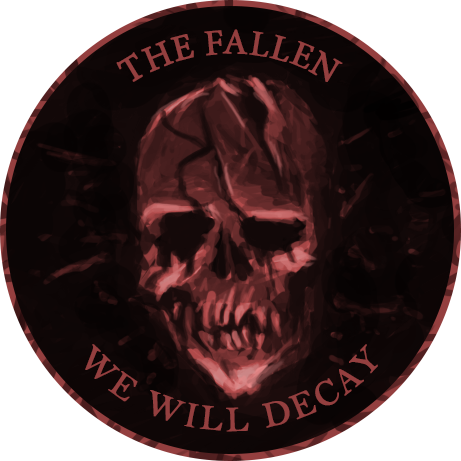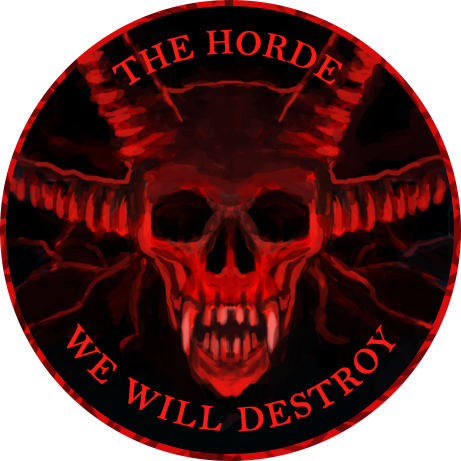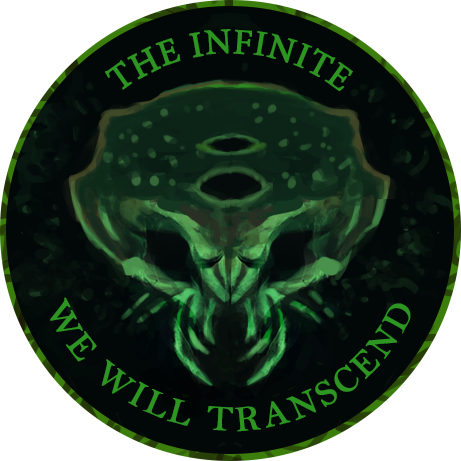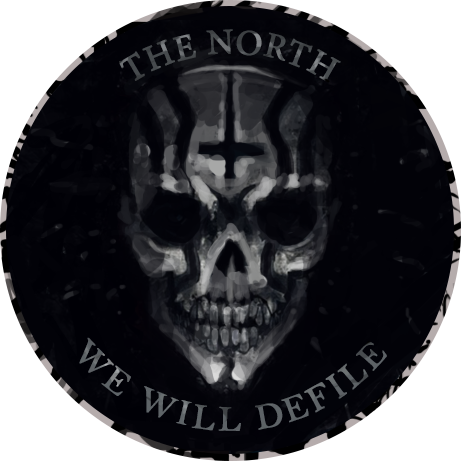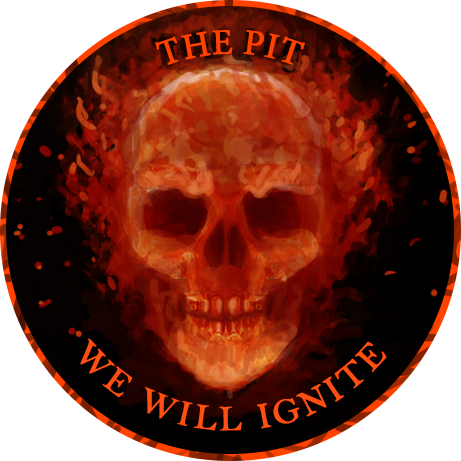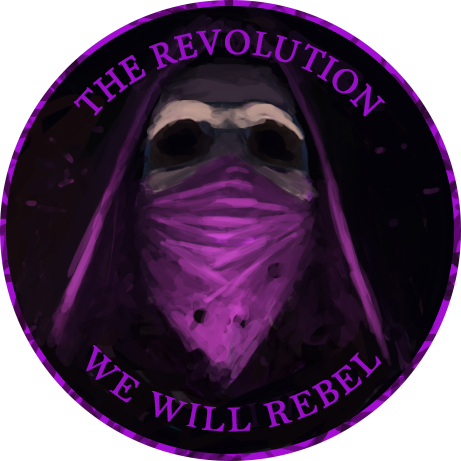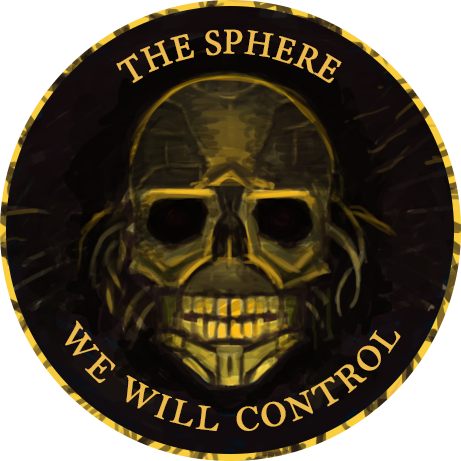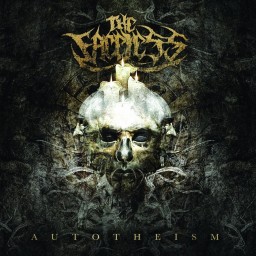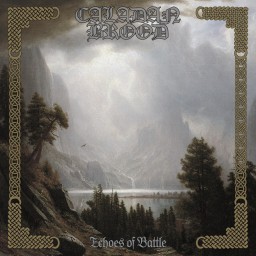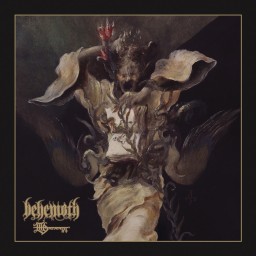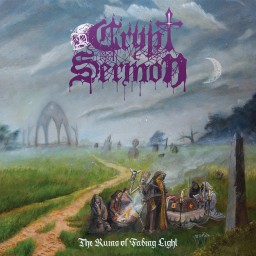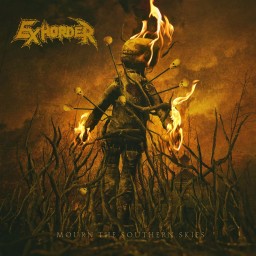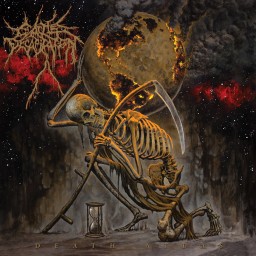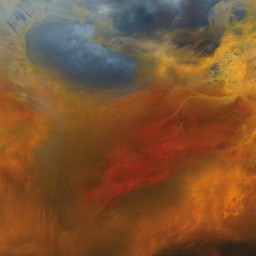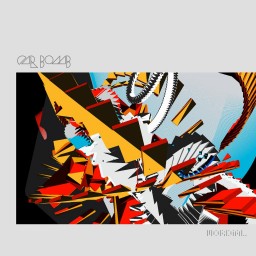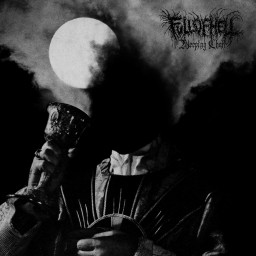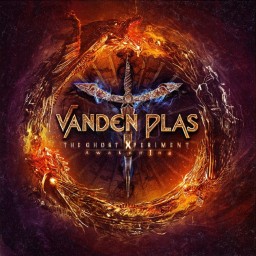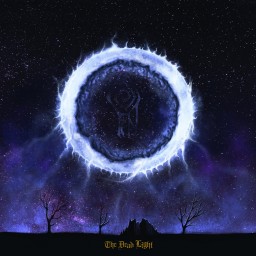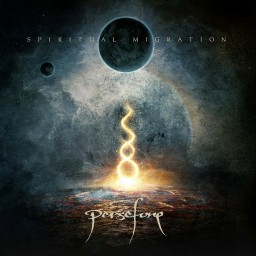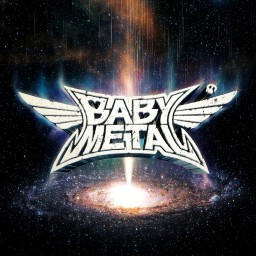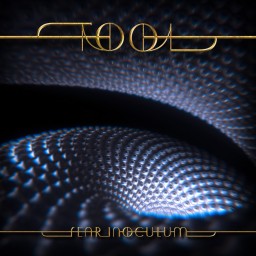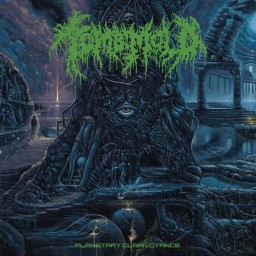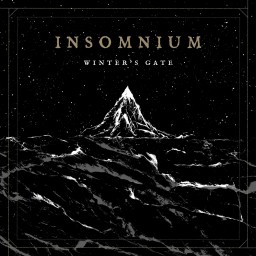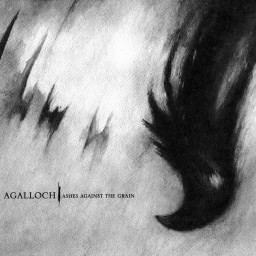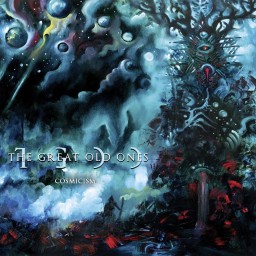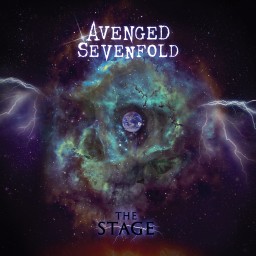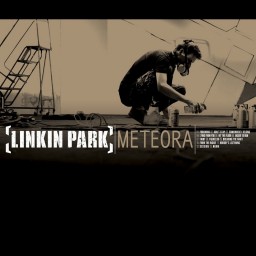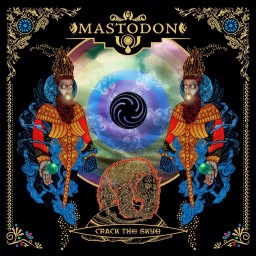Saxy S's Reviews
I vividly remember seeing The Faceless perform live along with The HAARP Machine in St. Catherines, Ontario in 2013. And while I was mostly there to hear the opening act, I was familiar with The Faceless from their album Planetary Duality. I remember them playing "Accelerated Evolution" and liking what I heard that I had to go back home after and find their album that song was on. So, I actually saw this band play live before ever listening to one of their albums in full.
Anyways, here's Autotheism, one of the better albums to split the difference between the melodic side of progressive metal, and the more punishing insanity of technical death metal. This album is all over the place production wise. And most of it comes in the percussion. And it's a shame because it's also in the one place that I have consistently criticized tech death for: the bass drum. When this album gets locked into a double bass groove, or a technical section where guitar and drums are in unison, it gets very loud and messes with the mixing of the remainder of the performers.
Still, songs like "Accelerated Evolution", "Autotheist Movement III: Deconsecrate" and "Ten Billion Years" all sound quite good, even excellent. And of course, to fit my namesake, when the saxophone comes in during "Deconsecrate", I really enjoyed it. I wish that it could have been projected more; sometimes the sax gets buried underneath the guitar backgrounds.
Technical Death Metal is still not my thing, but I can appreciate when it is done well. And The Faceless do create very solid tech death that doesn't rely on blazing fast song structures to cover up for unfinished songwriting. Good stuff.
Genres: Death Metal
Format: Album
Year: 2012
I was looking forward to hearing this: an atmospheric black metal band that borrows from bands like Summoning with symphonic and Celtic flare in it as well. Too bad the album sounds terrible!
The guitars sound like they are being recorded in 8-bit; almost like what you would expect heavy metal to sound like if it was coming out of your NES. Actually, when the opening track, "City of Azure Fire" started and I heard those woodwinds for the first time, I had to do a double take because those woodwinds to me, were unmistakable. That is the same melody that plays during a game of Age of Empires II. It wasn't exactly the same, but it was really damn close.
This album is corny as hell and not in the good way. This is meant to be listened to with masks off and something real and authentic, but all I hear is a bunch of trolling. Not a good way to start your career.
Genres: Black Metal
Format: Album
Year: 2013
Album of the Decade? Not Quite
If you were to ask me what the most important albums of the decade were; the ones that we can look back on in another ten years from now and say "that's what the 2010s were all about!" I would assume most people would say Behemoth's The Satanist somewhere in their top ten. And I would have to agree. This album is pretty filthy blackened death metal that someone like me would come to appreciate. It doesn't sound sloppy or unfinished. The production is solid and Nergal's vocal delivery is some of the best it has been in Behemoth's entire discography.
However, Behemoth are a band that have been doing this shtick for a long time and it should come as no surprise to anyone. Ghost get a lot of flack for being a satantic worship cult even though their music is way too safe and mainstream. If normies are worried about cults, this is the group that they should be worried about! But where Behemoth falls short of Ghost is those grooves and hooks that are desperately lacking.Most people who listen to this won't need them and I can understand. But outside of some great riffage and technical proficiency, this album just lacks the core to keep me coming back.
This isn't a bad record. In fact, it's pretty damn excellent. I just wish that Behemoth could do something more with the genre, the subject matter and the songwriting than this. Behemoth created this album almost as a jumping on point into death metal and it serves its purpose surprisingly well. But I like my melodic metal, which does make me feel isolated from the rest of the crowd at times, but I'll stick with Omnium Gatherum, Insomnium, and Scar Symmetry.
Genres: Death Metal
Format: Album
Year: 2014
When a band loses an integral member due to untimely death, it seems like an impossible task to replace them. Avenged Sevenfold dealt with this is 2009 with the passing of their drummer Jimmy "The Rev" Sullivan. After Mike Portnoy filled in for the remainder of that tour, Brooks Wackerman took over in 2015 and the band would release one of their most diverse albums of their careers. One of the reasons I will never fully respect Slipknot ever again is because of how poorly they treated touring bassist, Donnie Steele after the passing of Paul Gray.
The same can be said for Alice in Chains after the passing of Layne Stayley. William Duvall was tasked with attempting to win back all of those people who enjoyed this band during the 1990s who would, inevitably, call it half-assed Alice in Chains and that it would never be as good as Dirt or the self titled album. 2009 was proof of that with Black Gives Way to Blue, a serviceable record that lacked the sort of growth that one would hope from an artist with almost fifteen years layover.
So what did Alice in Chains do in 2013 with The Devil Put Dinosaurs Here? How about creating the most unique AiC album that changed the direction of the band completely, but also established this as not being Layne Stayley's group anymore. And while I will admit, this album did not click with me right away, but going back and listening to it again years later, I think it helps appreciate Rainier Fog even more when you see where many of the bones were planted (pun intended).
To begin, this album is immediately better than BGWTB because of its production. The guitars are seismic in their delivery, but they don't clip the mixing. As a result, the bass lines are also distinguishable and give even the albums slowest moments a sense of direction and forward momentum. And I would be remissed if I didn't mention the fantastic sounding vocal harmonies between Duvall and Cantrell here. I mentioned it during the last AiC review, but it almost sounds like Stayley never left us.
The songwriting feels heavier than ever before. The riffs are chunkier, the harmonies in the background vocals and melodic guitar passages are superb. The hooks from "Hollow", "Stone", "The Devil Put Dinosaurs Here", "Scalpel", and "Phantom Limb" are among some of the best Alice in Chains have had in this new era of the band. I love how this band moved away from the traditional grunge sound that made them so popular, but without losing much in the way of their unique identity.
Alice in Chains were always a dark and depressive group when it came to lyrical content. Many of the bands most influential songs: "Down in a Hole", "Nutshell", and "Angry Chair" were all deeply personal to Layne Stayley and his personal struggles that inevitably did him in. Where BGWTB was about coping with the loss of someone close to you, TDPDH addresses more general social issues; specifically the hypocrisy of religion. I love how songs like "Hollow" and "Phantom Limb" really flip off people who think that they can morally grandstand the plebs, but the mob is too large and the dissenting voices ring their words meaningless. Or how on "The Devil Put Dinosaurs Here", how these same people in power would denounce scientific evidence that the earth is a sphere or, as the title suggests, that dinosaurs never truly existed as a living species. They were instead placed by the devil to please the ever learning human mind. Who are you more likely to believe?
I'm not sure that Alice in Chains will ever be able to live up to the cosmic levels (pun intended?) of expectations that myself and a lot of other fans have unjustly placed upon this group. This isn't Dirt by any stretch, but it isn't supposed to be. This is the new Alice in Chains. Whether we like it or not, Layne Stayley is not coming back. This is William Duvall's Alice in Chains now. And it is magnificent. Many people were unjustly harsh on this album when it came out, myself included. I suggest you give this another listen. You never know what bones you might uncover.
Genres: Alternative Metal
Format: Album
Year: 2013
Much like the bands namesake, The Boats of the Glen Carrig is a seafaring horror novel that Ahab has created as incidental music to the 1907 novel. And wow does it really live up to its predecessor because this album can get pretty haunting at times.
This is death doom metal with elements of progressive rock and/or post-rock/metal interludes that really help encapsulate the feeling of being all alone on the water and the abandonment that one would feel upon shipwreck with no one around to guide or help them. The progressive sections are beautifully encapsulating of the moments of calm that one might feel when they are attempting to return to a stable state of mind, only to become engulfed once again in the fear and anxiety of a nightmare that feels like it is strangling you.
Unsurprisingly, the first thing that I thought of before I gave this album a listen was Mastodon's 2004 album, Leviathan, considering that they are built around similar concepts. And to be fair to Ahab, there are several similarities in the songwriting techniques used on this album as Mastodon's epic. Such as the invaluable importance of the guitar as melodic instrument, the fruitful bass and powerful vocal delivery. Unlike Leviathan, this album is long and it feels like it, and it's supposed to. The fear of isolation is so pulsating on this album that you start to question when salvation will finally come and rescue you and return to your life as it was before.
My criticisms of this album are few and far between, but they are significant critiques. For one, the vocalists low end is powerful, but it does sound a little too much like the Cookie Monster. And he alternates between the deep low gutturals to a more aggressive screams and there is just no comparison between the two. Also, the album is long. I said that it is a large part of this albums appeal, but some of these songs could have been cut down and given the same emotional impact, otherwise, the tracks could have been split up, making for a more streamlined experience.
Ahab's epic is a pretty damn great album in the death doom library. The atmosphere fits the source material extremely well, as well as the lyrical content. This album may hit you like the weight of the sea as it did the Glen Carrig. But the trip is worth the emotional roller-coaster that is displayed within.
Genres: Doom Metal
Format: Album
Year: 2015
Picture this if you will. One of your favourite bands of all time have been disbanded for well over a decade and you know fully well that their will NEVER be a reunion. But then, suddenly, it happens. The band reunites for a new tour as well as a brand spanking new album just to get the juices flowing. Who wouldn't be excited?
That's how I felt in the year 2009 when Alice in Chains release their first studio album in fourteen years; the first to feature William Duvall as the primary vocalist since the passing of legendary former frontman, Layne Stayley (R.I.P.). I wanted this album to be phenomenal. I have made it no secret that Alice in Chains were my first love in heavy metal and Dirt is my favourite of the big four "grunge" albums.
And what we ended up with was... this. I mean it's a respectable album for Alice in Chains and I would have never expected this group to top one of the most influential albums of a generation. But this album suffers hard.
Now part of that has to do with the higher expectations. I have learned over countless disappointments to never place an album in an elite tier before I have even heard a note on it. And while hindsight is always 20/20, I was only eighteen and easily excitable. And for what it is, Black Gives Way to Blue is a more than solid Alice in Chains record. But, like I mentioned with Tool's most recent album, when you have a layoff of this long, just making more of the same stuff as you did before feels underwhelming.
First off, the production on this album is abysmal! Alice in Chains were not the group that needed to get involved in the "loudness wars" of the late 2000s. Their sludge-y brand of alternative metal/grunge was always slow and brooding. If you took songs like "Rooster" and modernized them with this production, the dynamic swells of the verse/chorus combos would have failed to deliver any emotional impact. "A Looking In View" has this problem right from the get go, and their is very little room for reprieve; you better not be listening to this song with headphones because you won't be able to hear yourself think for nearly seven minutes!
And if you go to the ballads, dear god the ballads! This dynamic swell ruins ballads such as "Your Decision", which could have been fantastic, is ruined by a guitar that is louder than Duvall! And any time the drums come in, you can forget it!
Some of my personal favourite moments happen on "Check My Brain", which is a pretty catchy tune, and the first promotional single that I heard. And oh boy I was immediately sold on William Duvall. He has a vocal timbre that is impeccable and very reminiscent of Stayley. While songs like "Last of My Kind" and "Lesson Learned" are dank, brooding pieces where the low end really shines through, even with the blown out mixing.
Now with time, albums like this as well as Metallica's Death Magnetic have been remastered and most people who didn't hear the album back in the day have no idea what I'm talking about! And that's fair. With that said, I have listened to the album again, this time the digital remastering, not my day one CD from HMV. So why do I still feel underwhelmed by this?
Part of that has to do with the songwriting. As mentioned previously, this is the band's first album in over a decade. Part of this may have been the group just trying to get their name out there and remind people that "hey! We're still here!" But from the death of Stayley in 2002, to the first days of recording this album, Cantrell has been away from AiC for six years. Surely over that time, you would think that they would have picked up some new tricks. But they didn't. Instead they released a serviceable record that got people's attention, but were unable to hold that attention into the next decade.
Which is a damn shame because Alice in Chains would redefine their style on their next album, The Devil Put Dinosaurs Here, where Cantrell asserted to us, the fans, that this was no longer Lanye Stayley's Alice in Chains, but William Duvall's. But we will have to save that discussion for another time...
Genres: Alternative Metal
Format: Album
Year: 2009
What a strange album.
This is one of the weirdest black metal albums I've heard all year. This time, we're going to Switzerland to talk about some progressive black metal. I believe that the genre of "avant-garde" would be more understandable for an album like this. It doesn't seem to be intent on laying down pleasant melodic passages or brutal breakdown passages. This album is very atonal and takes all of the time it has to get going. This is further exemplified by the ritualistic nature of some of these song passages. It's faster than your typical drone metal dirge, but if slowed down, it could probably fit right in!
Overall, this album has some incredible highs, but also some very deep lows. When the album is at its best, it is transcendent, such as on "I Burn Within You" or "Ego Sum Omega". Otherwise you end up with "A Paradigm of Beauty", a song that does not feel like it fits in with the rest of the album at all. But I guess that is to be expected from an album like this. This feels like post-metal, but without any of the melodic importance. And yet I still can't turn away from it.
The vocals are clean and easily distinguishable, the guitar work is not extremely prominent, but it does create the atmosphere as one would expect from a post-metal project. The bass is strong and lays a steady foundation for most of the album, and the drum work is insane. The precision is commendable.
I have the sneaking suspicion that this album is going to grow on me more and more with repeated listens. But for now, I'm going to air on the side of caution and give it a recommendation, but not a full, unrestricted one. Perhaps a further endeavor into Schammasch's back catalog is required...
Genres: Avant-Garde Metal Black Metal
Format: Album
Year: 2019
A very solid dose of traditionalist doom metal, with a couple of new twists. For one, the guitar work on this album is pretty damn great! I like how the lead doesn't feel obliged to stay in the slower, melodic vein of the rest of the album and there are some pretty awesome shredding moments. The vocalist is pretty good at alternating between his cleaner lows and raspy high belting. I'm not a huge fan of when he growls though; it doesn't happen a lot, but it feels out of place and doesn't contribute much.
From a compositional standpoint, the album is pretty streamlined and most song ideas flow seamlessly from one into the next. The album does have quite a bit of meandering moments, highlighted by three interludes, two of them placed beside each other in the albums playthrough. Some songs also take their time reaching their conclusion, such as "The Snake Handler", even if the sum of its parts make it a pretty good song.
If I'm comparing this album to Spirit Adrift's album Divided By Darkness, this album is much heavier and more technically proficient. But from a melodic standpoint, it does feel like a lesser project. Still, the hybrid nature of this album is commendable. I hope these guys can iron out some of the kinks in the future because they have the potential to make something great. Keep an eye out for Crypt Sermon.
Genres: Doom Metal
Format: Album
Year: 2019
Since I don't listen to very much tech death, be sure to take my opinion with a massive grain of salt, but of the albums that I have heard in this vein over the last couple weeks, this is the one that sticks the most. It's pretty well produced (which is leaps and bounds ahead of any of its competition in 2019), and the ideas are still flowing from one track to the next. The album is still held back by many of my personal quips with the genre in general. It's scattered and it's played at such a blazing fast pace to attempt to hide the fact that many of these ideas are unfinished. I would still take this over Cattle Decapitation's Death Atlas, but it still doesn't sell me on the genre.
Genres: Death Metal
Format: Album
Year: 2019
Sooner or later, these eighties thrash bands who were not arbitrarily chosen as "the big four" will have to realize that the reason albums like Master of Puppets, Rust in Peace, and Among the Living are all time classic records is because of their bass presence, not just their riffage. Death Angel have been around long enough to know this, yet they continue to push out the same album with the same mistakes every three or four years. I'll stick to modern Testament until they decide to stop make ...And Justice For All clones.
Genres: Thrash Metal
Format: Album
Year: 2019
These guys have a really good Pantera impression on "Yesterday's Bones", and some of their slower groovy tunes are pretty solid (with the exception of "Hallowed Sound"). But on the tunes when they pick up tempo, like "My Time", "Beware The Wolf" and "Ripping Flesh", it's fairly obvious that these guys have one thrash idea and are going to beat it into the dirt. Fairly solid melodic groove metal, but nothing special.
Genres: Groove Metal Thrash Metal
Format: Album
Year: 2019
An album that is only slightly better than Full of Hell's Weeping Choir because the mixing isn't horrendous, some adequate melodic flashes and the vocalists low end which is quite solid. Otherwise, the songwriting is terribly blended, the clean singing is okay, but our singer sounds too much like Bobby Ellsworth (Overkill) in the worst way, the high screeches sound like a mix between Donald Duck and a dying Chihuahua, and the bass drum is overblown in the mix! I'm starting to think that triggered bass drums are the primary focus of this style of music and I'm not a fan.
Genres: Death Metal
Format: Album
Year: 2019
I don't understand the appeal of this
Because I don't partake in the smoking the devil's lettuce on a regular basis, I find it incredibly difficult to decipher who this album is intended for.
If you are intoxicated while listening, you naturally become tired, and I can see this as great music to fall asleep to, or as just noise in a quiet room. But if you're sober, you're just wondering why the hell no development of ideas has happened for nearly fifteen minutes!
Genres: Drone Metal
Format: Album
Year: 2019
The difficult challenge that many metal fans face is finding a respectable bridge to help cross the chasm into darker subgenres, and in this case, black metal. Alcest are the forefathers of the blackgaze subgenre that has become quite popular through the 2010s. Their first two albums: Souvenirs d'un autre monde and Écailles de lune are considered classics in this subgenre, and after a brief hiatus with Shelter which incorporated more post-rock than black metal, Alcest return with Kodama, a pleasant album for sure, but lacking in the many of the categories that most extreme metal fans would most likely scour at.
The guitars are produced beautifully; the balancing act of the rhythm guitar and the tremolo picking leads are superb and the fundamental bass and percussion are wonderfully balanced. Many of the main melodies however in the vocals and lead guitar feel lackluster in their performance as they feel left behind the heavy handed rhythm section.
I will say that one of Kodama's biggest faults is how slow it is. Given the fact that this is blackgaze, I cannot say that I find this surprising at all, but the overall simplicity of the tempo charting throughout this album does make it challenging to make any distinguished notes about the tracks on this album. It does have key variations so it is not as monotonous as you might think. "Eclosion" has a pretty melodic leads during the post-rock bridges, and "Oiseaux de proie" delivers an excellent display of pacing as Neige begins with melodic vocals, then opting for harsh screams, then ending with a atmo-black infused outro that serves as the best song on the album. And while "Untouched" attempts to copy this formula, it feels incredibly neutered by the lack of a release point.
If I can give Alcest anything, it that this is some of the prettiest sounding black metal you may ever hear. The wall of sound is not overbearing, and the songwriting leaves a lot of space making for some very comfortable soundscapes. This is the kind of black metal I would listen to on a beach, not locked up in my apartment surrounded by 10+ centimeters of snow. And for that, I give Alcest credit for standing out. While Deafheaven have proven that blackgaze can be just as much intense as the black metal tag would suggest. I do like this record, but would argue that it is one of the bands lesser works. Kodama should be seen as complimentary material to the first two albums.
Genres: Black Metal Post-Metal
Format: Album
Year: 2016
Medieval, folkened-black metal galore! And this album is quite solid as well. The guitar work does a large amount of heavy lifting on this album and makes for a very enticing experience.
I really enjoyed how this album was able to split the difference between its folk inspired sections and the heavier black metal sections. The band does an even better job of uniting them together in sections to give them their own unique appeal. It really creates the hybrid atmosphere that make you feel like the knights about to go to battle atop their horses. Obsequaie tried a similar idea this year as well, but failed to convert where it mattered.
Again, very solid album that you should not be deterred by just because of a potential language barrier.
Genres: Black Metal
Format: Album
Year: 2019
Genres: Metalcore Progressive Metal
Format: Album
Year: 2019
I have never been the biggest fan of either technical death metal, or grindcore for that matter. So to see the two of them plopped together sure didn't do this album any favors right out of the gate. But hey, the album is only 25 minutes, what harm could it cause? A lot actually.
My goodness, the production on this album is downright abysmal! How many times are you going to allow the guitars to clip in the mixing? How many times are the drums going to overpower the vocalist? How many times could I hear a bass on this album? I could probably count that one on one hand. Of all of the extreme albums I've listened to so far during my binge of 2019 albums I missed, this is easily the worst and doesn't deserve much of the praise that it is getting.
Genres: Death Metal Grindcore
Format: Album
Year: 2019
Genres: Progressive Metal
Format: Album
Year: 2019
To say that I have been anticipating this album would be an understatement!
To those uninitiated, Fen are a black metal band from London whose 2017 album, Winter is one of only a handful of albums that I could describe as “flawless”. Why? Well because it reminds me so much of Agalloch’s stunning album The Mantle from 2002. But where that album felt like the soundtrack to a beautiful cottage country that has just been dusted with a large amount of perfect, untouched snow, Fen’s album was more like a freezing rain that has covered everything in a coat of ice. Sure, it looks gorgeous and makes for some incredible photo opportunities, but then comes the realization that all of it will collapse under the additional weight brought by the ice, leaving behind an almost apocalyptic trail behind it. Both Winter and The Mantle are albums that should be held in equal regard, but for very different reasons.
So when I heard that Fen were working on a new album, you could see that I wanted to be one of the first to hear it. But I hindered my expectations a little bit; because nothing, no matter how hard the band tried, could ever live up to the astronomical heights that Winter delivered. So how is The Dead Light?
Well, it’s pretty damn great! But I was a little bit surprised to hear the branching directions that this group decided to take with this project. This one seems to borrow extensively from progressive metal as well as post-metal. There are even some sections that sound like they could have been borrowed from classic death and thrash metal. I don’t even know if “black metal” would be the proper genre definition for this album.
But the real question is how does it all fit? Surprisingly well actually. First and foremost, “The Dead Light Pt. 1” essentially kicks off the album after the extended intro “Witness”, by introducing us to odd time signatures and tempo changes. At first, you may feel a little surprised by how unprepared these transitions are, but before you know it, the band returns to the original idea with a seamless delivery. I really enjoyed how the group managed to take multiple themes and put them together and make them work. It also includes alternating passages of palm muted guitar chugging patterns, and the open tremolo picking and melodic phrases that have always been one of Fen’s strongest assets. Once again, how the group is able to compliment these sections and have them sound so good together is a nod to their songwriting prowess.
In addition to the actual construction of these songs, the production and instrumentalists need some due diligence. The bass (Grungyn) sounds phenomenal, as it usually does on Fen records. And the percussion work (Havenless) is pummeling when it needs to be, such as on the relentless song “Breath of Void”, but also relaxed and restrained when it needs to be as well such as the slower grinds of “Labyrinthine Echoes” and “Rendered in Onyx”. Lyrically, this album seems to be giving more attention to The Watcher’s clean singing. It isn’t impressive, but it doesn’t have to be. Maybe these sections could have been pushed forward in the mix a little bit more, or could have been moved to the slower, shoegaze sections.
Which leads us into the concept of dynamic control and where bands such as Fen and Saor are running circles around everyone else in extreme metal at the moment. Their attention to detail is superb and not enough can be said about how the transitions between sections and how they are intended to force the listener into restraint and control as they wait uncomfortably for the quieter sections to conclude and for the loud sections to return. The transitions aren’t as good as Winter, but they still sound quite excellent. Which is probably why the song “Breath of Void” is probably my least favourite on the project; it’s the least diverse on an album that has quite diverse styles, themes and emotions.
So in conclusion, The Dead Light is pretty great, but I didn’t expect anything else. The album is a breeze to get through despite what the total runtime might suggest. Each track has its moments that are uniquely Fen, but with enough new ideas and themes to keep longtime fans on their toes. It certainly isn’t Winter, but it is a light that you should definitely be following.
Genres: Black Metal
Format: Album
Year: 2019
Consider me a heretic, but I think that Persefone only got better after the release of Spiritual Migration. Don't get me wrong, this is a fantastic album, but something about it just doesn't resonate the same way that Aathma does. Some of that might have to do with the heavier focus on technical wanking than melodic songwriting; chugging guitar riffs, never ending time signature changes, technically demanding guitar and percussion elements. But what amazes me above all of it is how well it all fits together! Given my history and my general distaste for technical death metal, there is no reason why I should like an album like this. But each tracks flows effortlessly from one into the next and before I realize it, I have listened through the entire album again! I really enjoy the thematic songwriting on tracks like "Mind as Universe" and "Spiritual Migration". I really like how the band takes a breather half way through the project to play a melo-death instrumental in "Consciousness". "Inner Fullness" and "The Majestic of Gaia" should appeal to any tech-death fans out there.
Persefone would only go on to get better with more melodic songwriting and greater concepts in 2017 with Aathma, but let's not forget the album that put Persefone on the map. Going back on this album near the end of the 2010s and hearing it again, I can attest that Spiritual Migration is one of the decades most influential heavy metal albums. Progressive and technical death metal owe a lot to this album.
Genres: Progressive Metal
Format: Album
Year: 2013
This a gorgeous sounding atmospheric black metal album that really doubles down on the atmospheric part of its genre definer. The album is called Hallucinogen and it feels like a trip!
For one, the guitar work on this album is a standout. I really like how it is able to effortlessly transition from acting as a melodic instrument to a harmonic one with its tremolo picking patterns. The vocals, while not incredibly great or prominent, do serve their purpose. They feel like an afterthought, but the clean singing sections are sung with a very slow, brooding feel, almost like a religious hymn. The harsh vocals are sparse but effective. The foundation provided by the percussion and bass does its job and emphasizes the low end extremely well. The mixing of the percussion is top notch, not allowing the almost mechanical double bass work to clip in the mixing, while still being prominent enough that you will notice it.
This is a great little project that can be appreciated by many. Definitely one of 2019's sleeper albums IMO.
Genres: Black Metal
Format: Album
Year: 2019
I have found myself very distant from the metal community for quite some time. It seems like every time a new there is a new progressive-djent/avant-garde/extreme brutal death metal band doesn’t garner any mainstream attention, those fans complain that not enough people are listening to their new favourite artist. However, when a metal band manages to garner a little bit of mainstream attention, everyone loses their minds that their precious genre is being commercialized. Everyone needs a starting point to get into the different music genres. For me, it was the 90s output of Metallica, with the Load and Reload albums (I’m too young to remember the self titled album).
The new craze of the 2010s has been BABYMETAL, a J-Pop duo whose backing band uses distorted, and drop tuned electric guitars and double bass drums. None of these are bad things on their own. And hell, even the bands last album, METAL RESISTANCE, was a branch away from the very coy, happy-go-lucky nature of the self titled album. So I could only hope that METAL GALAXY would continue this trend.
Alright, props to everyone involved for experimenting with some new sounds. However, with an album called METAL GALAXY, it is pretty obvious from the start that this is going to be a more electronic metal experience. The opening track “FUTURE METAL” is proof of this; lots of synth and electronic percussion. And while this isn’t always a bad thing, BABYMETAL are a group that could have desperately used some better mixing of the electronic elements.
For one, the opening track “FUTURE METAL” uses these really generic sounding guitar tones, matched with a poorly mixed percussion whose bass thumps clip the mic and don’t sound pleasing at all. The vocals are almost always pushed to the front of the mix, but when the singer is in her higher register, it peaks on tracks like “PA PA YA!!” and “Starlight”. Otherwise, you end with the pitch corrected “IN THE NAME OF”, where the vocals are pitch shifted to Hell itself, over a Slipknot B-side.
Other tracks are mixed better; “Shanti Shanti Shanti” is alright and I really liked the atmospheric elements added to “Kagerou”. The group is at its best when the guitars are given heavy prominence, like on the power metal outro “Arkadia”, the counterpoint between voice and guitar on “DA DA DANCE” and the quasi-ballad “Shine”.
The experimental elements come in the form of hybrids with other styles of metal. “Shanti Shanti Shanti” has melodic passages that sound borrowed for oriental metal, which I respect, but artists like Orphaned Land have pulled sound off with organic tones much better in the past. “Oh! MAJINAI” borrows from folk and pagan metal as it uses bagpipes as a secondary melodic instrument and every time I hear it I can’t wipe that stupid grin off of my face. It’s so goofy, yet still very satisfying. “Distortion” is the groups attempt to crossover as it calls upon Alissa White-Gluz of Arch Enemy. And I already mentioned the power metal “Arkadia”, and the atmospherics of “Kagerou”.
As for the vocals themselves, they sound okay. I find that more often than not, when the vocalists are higher register, they peak in the mix and don’t really allow for any subtlety in the instrumentation. Of course, BABYMETAL is also dealing with the fact that they have lost one of their members since the release of METAL GALAXY. The vocal layering sounds fine, but it is quite obvious that a lot of the vocals have been fixed in post-production, which is a little disappointing.
As a whole, METAL GALAXY is a serviceable metal/pop record. I think that the group has had better days and that many of the experimental elements on this record don’t work as well as previous albums had. Still, there is nothing overtly offensive about it; this is pop music with crunchy guitars and djent-y breakdowns. If that sounds like something you would like, you probably will.
Genres: Alternative Metal
Format: Album
Year: 2019
Lots of Potential, but so many Missed Opportunities
This is quite the ambitious project for a group only on their second album. For those of you who are unaware (and given this band has zero ratings on the website, a lot of you are unaware), White Ward are a Ukrainian post-black metal band whose debut album, Futility Report made its way on to my radar when it appeared on several year end lists for 2017. I liked some of the ideas, but they were handicapped by some really bad production. And so I saw this album rank pretty high on RYM, so I decided to give White Ward another chance to impress me.
The production and songwriting issues I had with the previous album still hold up, but I can give credit where it is due as the true black metal sections have improved dramatically since 2017. The guitars actually have some natural growl to them and aren't near the front of the mix, drowning out the bass. The vocals are fine enough, drawing a lot of inspiration from George Clarke of Deafheaven. But if you're expecting the rest of this album to sound like Deafheaven, you would be sadly mistaken.
White Ward are not looking to cheer anyone up with these tunes; the typical major key harmonies of albums like Sunbather are nowhere to be found. And the walls of sound are broken up in sizable chunks with slower, atmospheric sections that borrow more from shoegaze and jazz. Yes, jazz. The saxophone as a primary melodic instrument has been improved from the last album at the very least in its tone. That is to say it actually sounds like a saxophone instead of sounding like my crappy MIDI soundboards saxophone tone! However, this is a black metal album, and the horn does sound like it is being drowned out considerably when it is being used during a heavier section. Bands such as Rivers of Nihil, and Moron Police have incorporated saxophone in metal much more efficiently in recent years.
The songwriting is a little worrisome. I like how the group tries to get a little bit progressive with their songwriting as tracks can modulate through a number of different ideas throughout their runtime, but they never feel like they reach their end goal. I have always been a stickler when it comes to progressive songwriting and bringing these long musical journeys back to where they start, or at the very least, return to a major theme or idea. These tunes feel more like a collection of ideas that were just thrown together to make longer songs without putting in the work to make those transitions work.
It is a little bit better than Futility Report on aggregate so I would recommend it, but I would be very cautious. White Ward's sound won't be for everybody; it's a specific brand of black metal that asks the listener to chill out instead of forming a circle pit. And if that's what you're into, more power to you. I just have heard this sound done much better in recent years. By Deafheaven or otherwise.
Genres: Black Metal
Format: Album
Year: 2019
In Mourning are a Swedish metal band who specialize in progressive metal, but are also willing to get crunchy with some death metal tones as well. I have been looking for a while to find a group who were willing to make this hybrid leap and succeed, as most of the "progressive death metal" in 2019 has felt very underwhelming. And I did like what I found within Garden of Storms.
For starters, the album kicks off with a bang with "Black Storm". I really enjoyed how the heavy percussion complimenting some really sweet guitar melodies. The bass and drums are produced quite well and Tobias' vocals sound very good. The transitions between harsh growls to the equally strong, yet relaxed clean singing is excellent.
This album unfortunately doesn't do a lot for me after the opening track until about the midway point. Sure, "Yields of Sand" and "Hierophant" sound very good and there is nothing offensive about them, I just don't have very much to say about them. Imagine some of the strongest, and loudest moments from Opeth's Ghost Reveries from 2005 and you'll have a pretty good understanding at what you're getting into.
I think that marks my biggest problem with this album as a whole. It's clear to me that this group want to be like Opeth circa the mid 2000s, but lack the originality that makes them standout. Tobias' harsh singing has an uncanny resemblance to that of Mikael Akerfeldt, which push the comparisons even further. I know this is a butchering of the sound, but imagine if Opeth didn't have the lush strings, flutes or synthesizers throughout the 2000s and you'd get something that sounded like In Mourning.
It isn't all bad though; "Magenta Ritual" is actually a very solid slower moment on the album where the dynamics contribute so much. The next track "Huntress Moon" is also excellent. This is the closest the album gets to really digging into true death metal tones; blast beat drumming, chugging guitar riffs and pummeling vocals, but it's all anchored by a subtle, yet powerful tremolo lead guitar that soars over the rest of the ensemble and makes for the original song as well as the albums highlight.
The album ends on a bit of a sour note with "The Last Outpost". The vocal effects around Tobias' during the bridge and some less than stellar songwriting, make the longest track on the album feel longer than it really should. Again, it feels more like a Ghost Reveries B-side than an original idea. And after I just finished listening to the new Wilderun album, it's hard to not compare the two on how to take influence from one of the most influential prog bands of all time. One is respecting the past, while paving their own, unique direction, while this is paying their respects, but not innovating further.
And that leaves me in a bit of an odd position because I do like this. Ghost Reveries is one of my favourite Opeth albums and more of that is always great. But the fact that it cuts back many of that albums unique charm in the instrumentation, but never compliments it with original ideas of their own, leaves me feeling more lukewarm on this than I wish. It is still good, but not great.
Genres: Death Metal Progressive Metal
Format: Album
Year: 2019
Oh How the Giants Have Fallen
Look I don’t have very much to say about this new album from Within Temptation. It’s been five years since Hydra came out and with an extended hiatus period like that, you would think that the group would be able to release something a little bit more interesting than… this.
And I hate saying that because I love Within Temptation, they are established veterans in the power metal genre that I imagine many similar bands look up to. But with this? Within Temptation, pardon the pun, gave in to the ever growing number of rock bands implementing more synth heavy music with piss poor production.
And oh my god, the production on this album is downright abysmal; compressed synths that pierce over the rest of the mix, a kick drum that is forced to close to the microphone, a snare drum that has so much reverb it couldn’t possibly have been recorded from an acoustic set, buzzy guitar tones that reminisce to the heavier, and worst, tracks on the last Bring Me The Horizon album, or in the case of “Holy Ground”, replaces the guitars altogether with blasted out synthesizers. The only thing saving the production from making this album worse is the dynamic contrast, something that Within Temptation have always be masters of. But they can't even pull that off correctly! The loud/soft dynamic is entirely based on whether or not the guitars are playing! And all of this leaves Sharon den Adel in a very unfortunate situation. Because let me be honest, Sharon’s vocal presence is what makes Within Temptation. When all of this is more prominent in the mix than Sharon’s vocal delivery, you have a massive problem.
So yeah, definitely not recommended even for Within Temptation fans. This is the wrong direction for the band and it does not make them look good. If you really want a power metal fix in 2019, wait a couple weeks for that new Avantasia record.
Genres: Alternative Metal
Format: Album
Year: 2019
Well… this happened. It wasn’t quite 10,000 Days, but it sure felt like it to longtime fans of this group, which I include myself into that list. 13 years since the last album. TOOL have always taken their time releasing new music, but this was unprecedented. But, the legal disputes that this band found themselves in kept them out of the 2010s almost entirely. And as a result, their music was only just released on streaming platforms within the last month, which must have made the wait feel even longer!
I’ve gone back and reviewed every single studio release in anticipation of this, so if you want to know where I stand on one of my favourite metal groups and their discography, knock yourself out. But going into Fear Inoculum, I had no idea what to expect. I tried my to hinder my anticipation as more information was revealed because... there was no way this could live up to the sky high expectations that the TOOL cult have given it. So here we are. How does it stack up as a metal album in 2019? How does it compare to the rest of the groups music? Was it worth the over decade long wait?
Well… yes and no. For one, I am finally glad to see TOOL back making new music that is as polished and unique for a time where progressive rock and metal seem to be in full nostalgia effect. The bad side is that, despite my best efforts to not do this, TOOL haven’t really evolved that much since 10,000 Days. And as a result, the new album feels… underdeveloped. Not bad by any stretch; TOOL are a competent enough group to never release anything “bad”, just not where it should be.
And before we begin, I have to mention a couple of things. First, that this review will discuss only the tracks on the physical release. Not that the electronic interludes on the digital release are bad, but because they act more as moments of reprieve rather than contributing to the experience.
The other that needs to be abundantly clear to the cult fans that this album must be compared to modern metal albums, not just other TOOL albums. Because (1) the last TOOL album came out in 2006, and (2) the landscape of progressive rock/metal isn’t the same as it was back then either.
So to begin, if Lateralus was the band experimenting with their progressive side, and 10,000 Days was the band attempt at commercializing that sound, then Fear Inoculum is TOOL experimenting with “progressive sludge metal” or “atmospheric sludge metal”. These songs are long; not a single “song” is less than ten minutes. And many of them are built around a handful of different melodic themes and ideas that are woven together to make these songs worth their runtime. “Pneuma” starts with a disjointed guitar riff during the verses, and the chorus consists of long tones, while Danny Carey fills around the drum kit. The later portions of this song combine these two ideas together quite wonderfully.
And now I commit the first act of heresy by comparing TOOL to another band. And the album that I kept comparing this to was Winter, the 2017 masterpiece by English black metal band Fen; an album that at the time I gave a perfect score to and upon revisiting it, I stand by my score. That album was long as well and used brooding quiet sections to compliment the thunderous blast beats and howling vocals. Also as an item to make you, the listener, anticipate the release even more. With this, while many of these songs do manage to pull off dynamic contrast and release exceptionally well, it gets a little tiresome when they all follow the same formula.
Don’t get me wrong, “Invincible” and “Culling Voices” are two fantastic tracks, but especially for the later, when you know what’s coming before you’ve even heard it, that’s a problem. It’s why tracks like “Pneuma” and “7empest” are a little bit more unique, with “7empest” being a heavy metal assault from beginning to end. It does still have some strong dynamics, but nothing like the reprieve of the tempo change during the bridge of “Invincible”.
The title track is a song that could have been cut down to size a little bit, especially during the outro. The song starts off pretty post-metal, before transforming into an odd time signature riff that at least feels like it belongs with the beginning, but the outro just sounds like TOOL and didn’t fit in. The same can be said for “Descending”, a track highlighted by its last seven minutes as a jam session with prominence on Adam Jones guitar solo. I like the melodic stuff, but the chugging riffs just go on way too long. A damn shame because the first half of that track is phenomenal.
Which takes us into the performers themselves. As I said, Adam Jones seems to have much more prominence on this album as a melodic instrument than even before. Just look at “Descending” and “7empest” for that. Danny Carey is killing it on “Pneuma” and “Chocolate Chip Trip”. Justin Chancellor’s bass work is as prominent as ever and everyone complaining about how Maynard’s vocals sound need to stop. He’s 55. His voice has been dipping since Ænima, give him a break.
From a production standpoint, it’s not surprising that on an album that is diving even more into the atmospherics of sludge metal, TOOL is using more electronics and synthesizers on this album. It also wouldn’t surprise me if they’ve been listening to a lot of ambient, spacey, electronic music. Specifically, the Mass Effect: Original Soundtrack. The spacey intros of “Fear Inoculum” and “Culling Voices”, the dank low synth tones that are prominent on the outro of “Descending” and the electronic ostinato on “Chocolate Chip Trip”.
Okay, so what are the band trying to say on this record? Well this album seems to be showing the band at their most fearful/anxious. The critical point is when Maynard becomes personal on “Invincible”. Perhaps a very relevant song for the group, as they were forced into hiatus while they were still at the peak of their popularity, the band worries whether or not their fans will return to them.
“Fear Inoculum” discusses “The Deceiver”, an antagonist character who has brought our protagonist misery and anger, and the protagonist now begins to reject them. “Descending” is the band showing their fearfulness for the future of our planet and how our irreversible damage may cause the downfall of humanity as we know it. “Culling Voices” discusses the echo chambers that we form as individuals (in our own head) or as part of a group, and how constant replies of assurance are inevitably bad for us. And “7empest” is the rejection of the authority figures who tell the people lies to further their own narrative. And when those figures are called out for it, they blame somebody else. How relevant in 2019. With the themes of fear and anxiousness near the front, it makes sense as to why some of these songs feel long: these opinions are not fully formed or realized yet. They need to be refined and cut down to the proverbial meat and potatoes. I think for what the band is trying to say, the lyrics match the songs, even if I don’t like it.
So where are we? TOOL’s Fear Inoculum is a puzzling project. One that requires the attention of the listener to really grasp everything that is going on. That is to say, make sure you’re sober when you listen to this. It’s far too long for its own sake and should have been refined. As a metal album in 2019, it does stack up favourably to whatever the heck that last Slipknot album was, but compared to Saorand Spirit Adrift? Not so much. What about compared to other TOOL albums? It’s certainly a better than Ænima and it will have longer staying power, but compared to Undertow and 10,000 Days it feels like a step down. It’s a good comeback album, but it should have been a lot better.
Genres: Progressive Metal
Format: Album
Year: 2019
So here’s an album I never thought I would be covering. Tomb Mold are a local band from Toronto, Ontario, Canada who are creating some straight up death metal. Now I have mentioned before that I am not the biggest fan when it comes to this genre, primarily because of its insistency of not writing hooks or melodies to keep the tracks engaging or at least interesting and instead, collectively wanking their instruments to see who can play the fastest. Now I heard parts of this bands 2018 album, Manor of Infinite Forms in passing last year and I was impressed by what I heard; the songs themselves were anchored by some pretty decent guitar melodies, even if they were a little bit more downplayed than what I would have liked.
So what did we get this year with Planetary Clairvoyance? Well, we got ourselves another solid Tomb Mold album, one that I think is better than the last one, just in concept alone, but the music itself is also quite solid.
Now I will remind you all that this is death metal album and is absolutely not for everyone! As I said off the top, death metal isn’t even my cup of tea. But one thing that this album does have is some pretty solid song structure and songwriting. The guitar lead that anchors the outro on the opening track “Beg for Life” is one of the albums highlight moments, or the very solid guitar work that lays the foundation for “Accelerative Phenomenae” and “Cerulean Salvation”. Also, the first half of the title track is very well performed as well.
“Infinite Resurrection” is a very solid tune right in the middle of the album, which feels to me like it signals a change of pace in the album. It’s a very good song that features a lot of different ideas that are crafted together very well and none of those transitions feel like they are out of place. That carries on into “Accelerative Phenomenae” and “Cerulean Salvation” as well.
However, some of these ventures do not bring positive returns. For one, the second half of the title track is alarmingly bloated as the guitars lose the rhythm entirely. Then there is a tempo change that feels unnecessary and pads the songs length even further. Or the doom metal influence that brings the closing track, “Heat Death” to a snail's pace conclusion. It really wasn’t a great way to end the album. I understand its purpose thematically, but that still doesn’t mean I have to like it. Also, this may be a little nitpicky, but I wish that Tomb Mold would have gone ahead and included a few more clean sections of reprieve like the bridge of “Beg for Life”.
Another big problem that I have with death metal in general has to do with the lyrics and the delivery of those lyrics. Now this really shouldn’t bother me since I listen to post-metal and black metal, but the delivery of the lyrics on Planetary Clairvoyance is actually pretty strong. Max Klebanoff is pulling double duty as both the drummer and vocalist and while I do wish that his vocals could have been a little bit more pronounced, most of the vocals are clear and are easily audible. There were a couple of moments such as the mesh pile that was “Planetary Clairvoyance” during the outro, but that obscurity is few and far between on this album
To summarize, Tomb Mold are appealing to a specific brand of death metal audience that I am certainly not apart of. I’ve always gone back towards the melodic side of death metal with bands such as At the Gates or Insomnium. But for what it is, Planetary Clairvoyance is actually pretty good. It probably isn’t something I’ll come back to all that much, but I can appreciate quality when I hear it, especially compared to other death metal bands in the same vein. So yeah, get in the spaceship before it get consumed by a black hole or whatever.
Genres: Death Metal
Format: Album
Year: 2019
Did Insomnium Make the Death Metal Album of the Decade with Winter's Gate?
Well I guess that depends on who you ask. For starters, this isn't an easy album to take in; it is one single, uninterrupted song that clocks in just forty minutes. To some of the more acquired death metal fans, they may see this as a write off; this band is simply trying to recapture the magic in a bottle that was Edge of Sanity's Crimson, and that there was no chance that this album could be as good or even better than its inspiration.
But as someone who is nowhere near as well versed in the genre as many of the other great users on this website, I just can't stop coming back to this record. Not since bands like Be'lakor and Scar Symmetry have I been this entrenched in a death metal album. And not since Crimson have I heard an album in this style sound this dense, thoughtful and epic.
Part of my love of this record is that it takes influence from the source material, but then gives it a new and unique flare. This isn't meant to be Crimson Part III, but its own individual project. I guess that melodic death metal is the best classifier for this album, but it doesn't stay there very long. This album has elements of symphonic metal, progressive metal, melodic/atmospheric black metal, and even doom metal. And each of these different ideas are crafted together with effortless transitions and unparalleled technicality.
The first thirteen minutes of this album is absolutely insane! The heaviness of the guitar parts creates an outer worldly atmosphere and they suck you in like a black hole. The percussion work is ridiculous with lots of double bass drum, long drum fills and blast beat passages, but the mix keeps the percussion back; not far enough that it can't be heard, but still strong enough to really carry these songs forward. The bass work on this record is phenomenal, having its own unique riffs that are counterpoint to the guitars, and the vocals are gritty and precise. The clean singing is sparse and I wish it could have been used more to emphasize certain hooks, but it sounds very cool, with just enough reverb to keep the atmosphere of the instrumentals alive.
The way this album slows down around the twenty-five minute mark reminded me a lot of Paradise Lost in a really good way. Maybe a little too much at times, which does unfortunately mean I have to dock a couple of points for lack of originality there. I also have to mention that even though the album is just one track, the breakdown of the album is a little boring by the time you reach the final six minutes. The lack of harmonic change until the very end gives of the impression of a stoner metal album.
But those are just minor quibbles on what is my favourite death metal album of the 2010s. I don't think it will ever live up to its source material in terms of quality or cultural significance, but Insomnium's Winters Gate is a triumphant achievement in the bands extended career.
Genres: Death Metal
Format: Album
Year: 2016
Baroness have always been a strange band for me. While the band has always been a good one with some stellar albums such as Red Album, Blue Record, and Purple, this band has always been able to impress me with a new brand of progressive sludge metal each time. With Purple being the most recent example, calling on the assistance of producer Dave Fridmann, for one of the bands most laid back projects.
Now with Gold & Grey, the band have called upon Fridmann’s services once again. And the result is… well, certainly not bad by any stretch, but it is absolutely a step down from their previous output.
And most of the blame has to be put on Dave Fridmann again, just like it was with the last album. Yes, I still do really enjoy Purple, but some of the production choices kept the album from being an epic masterpiece. And that still applies to this album, particularly in the percussion. I don’t know what Fridmann was thinking, opening the album with a bass drum that is swallowing everything around it in the mix on “Front Toward Enemy”. This continues into the next song, “I’m Already Gone”, in which the guitars have been compressed just so that they don’t peak in the mix. It also doesn’t help that John Baizley’s vocals have also been compromised.
Now if you divide this album into its three main parts as Baizley has described it, then I can give credit that part one is easily the worst. Parts three mixes the percussion a much better on “Broken Halo” and “Borderlines”. Part two is much more restrained, and does not use that much percussion at all. Only “Throw Me an Anchor” and “Cold-Blooded Angels”, which might be my favourite song on the album, have an aggressive drive. “I’d Do Anything” is an excellent tune which shows restraint and excellent use of dynamics as the song modlates from piano, to acoustic guitar arpeggios, to electric power chords. And “Emmett - Radiating Light” is an acoustic song with chimes and some wonderful vocal harmonies from John and Gina Gleason.
Now parts two and three might be the album’s better pieces, but that doesn’t make them perfect. For one, the bass lines on this album are nearly non-existent. Whether that be because of the compressed guitars on the first third, or the bass line just copying the guitars on the remaining two-thirds. The only tracks where the bass is given a prominent role are “Tourniquet” and “Borderlines”. And then there is the problem with the overblown percussion during the outro of “Throw Me an Anchor” and the closing track “Pale Sun”. If you already found the sound that works, why would you go and bastardize the ends of a pretty good song and album, respectively?
In addition, I have to bring up the structure as it relates to the instrumental breaks. Because of the inflated production, none of these songs have a genuinely great counterpoint to John’s vocals. The only song that comes even close is “Borderlines”, but that song has three seperate guitar solos! Maybe pass them around to other songs to make it more streamlined?
My other big problem has to do with the fazer effect and it abuse on this album. Whether it be on the piano interlude “Sevens”, the acoustic guitar on “Emmett - Radiating Light”, or even on the vocals on “Broken Halo”. It’s something that could have been effective if it had only been done once or twice, but every single track has it! When you know it’s going to happen, it less cool and “progressive” and more of catering to a quota.
I know this seems way too negative for an album that I did still enjoy, but it Baroness! I know that John Baizley and the rest of the crew have what it takes to create a truly remarkable album. And this isn’t it. Someone else actually commented on this album, suggesting that this was the ...And Justice For All of Baroness’ career. And while I certainly see the comparison with a lack of bass, the album that I’m reminded of more is Death Magnetic. For all of the crap that AJfA takes for its nonexistent bass, at least it isn’t overcompressed mush. Now Gold & Grey, certainly isn’t overcompressed mush either, but there are some alarming warning signs with this album, and I would be very cautious if I was Baroness going forward.
Genres: Stoner Metal
Format: Album
Year: 2019
So I thought I check out a new album from Bandcamp and found the band Spirit Adrift, a doom metal band from Phoenix, Arizona. Now, being primarily a metalhead, I have never really been the biggest fan of doom metal as a subgenre. And it is the same reason why I am not a huge fan of most extreme metal subgenres. Mainly, their lack of attention to melody and songwriting. With both, they would rather focus on tempos, whether that be the slow, drone like guitars of doom metal, or playing technically demanding music without any melodic groove in extreme metal. So I was not expecting much out of Divided by Darkness.
And thus it is my duty to remind every single one of you of a very important mantra: never judge a book by its cover. Yes, this is doom metal, but Spirit Adrift are making melodic doom metal; one that has influences from traditional heavy metal, thrash metal, and even power metal.
So to start, let’s break down those influences. Nate Garrett has a very powerful voice that has an uncanny resemblance to Ozzy Osbourne, only with a little extra grit. He doesn’t try and keep it cool during the chorus of “Divided by Darkness” just to keep the comparison. From thrash metal, you have songwriting that contains faster grooves and melodic counterpoint provided by the guitars; with “Angel & Abyss” upping the ante by having a second half that could have been borrowed from any Anthrax album. And from power metal, the strings that accent the outro of “Tortured by Time” and the synths that highlight the transitions and outro of “The Way of Return”.
But, this is a doom metal album first, and some of my favourite moments are when the songs modulate to these clean guitar sections. They have a very similar pickup to those found on the last Altars of Grief album, Iris, released last year. “Born into Fire” and “Living Light” both use these and they sound really pretty.
But what will make this album stand out are its transitions and the songwriting. I already mentioned the superb second half of “Angel & Abyss”, but most of the time the band actually goes from thrash to doom. “Divided by Darkness”, “Born into Fire”, “Tortured by Time”, and “Living Light” are all great examples of this.
And as for the songwriting, I don’t know what I can really say besides: “listen to the album!” It’s doom metal that allows for melodic importance throughout the project. “Hear Her” is the most accessible track on the album, making it incredibly easy to pick up, but “Tortured by Time” is an immediate standout. Throughout the album, the guitar holds the album together with contrapuntal melodies and technicality during the solos. On this track, the guitar is all melody; no ridiculous fancy guitar tapping solos, but it is just as effective in terms of creating the mood the band is going for.
Now I do not think that this album is perfect. One of my biggest critiques is that too many of these tracks resort back to a paint by numbers formula of: fast intro with verse/chorus combo, followed by a drop in tempo to more traditional doom style for the bridge and outro. With “Living Light” probably being my least favourite track on the album. The fast beginning feels more like an extended intro before having its tempo drop for the remaining three minutes, of what is essentially an instrumental. It’s why when the band flips the roles on “Angel & Abyss”, it’s really striking and easily my favourite track. I even like “Hear Her” because it doesn’t make that change.
But in summary, Spirits Adrift have released an excellent album that may feels very transitional. But after bringing in thrash, power and even progressive metal elements throughout the album, it leaves me with a lot of joy to see where Nate Garrett could possibly go next. This is one of the best metal albums I’ve heard in 2019 so far and if you’re looking for a new face in metal to check out, this is a great place to start.
Genres: Heavy Metal
Format: Album
Year: 2019
It's rare for one artist to be able to accomplish the feat of creating two near flawless albums over their run. Nick Cave has done it, but not over a span of back to back albums. Agalloch's Ashes Against the Grain may forever be in the shadow of its older sibling, but make no mistake, this album is special in ways that The Mantle just couldn't.
And while this album is still clearly the Agalloch who released The Mantle four years earlier, it sounds drastically different. A hybrid of multiple genres infused together to create something unprecedented; either for the time, or even today. You've got post-metal, you've got progressive metal, there is black metal, doom metal, folk tendencies. This album truly pushed the boundaries as to what heavy metal could possibly be in the 21st century.
The production of this album is phenomenal, perhaps even better than that of The Mantle. The guitars are cleaner with a stronger prominence towards melody instead of blackened tremolo picking. The bass is given enough independence from the rhythm guitar to make this album sound even bigger than it is. The percussion is tighter than ever before, which significantly helps the forward momentum of these tracks. The effortless transitions between harsh growls and drone singing might not be revolutionary, but it is effective. And those drone singing portions are also much improved and are given more importance than previous albums.
The compositions? What can I say? "Falling Snow" has gorgeous riffs and a beautiful arch. "Fire Above, Ice Below" starts peaceful and calming, but is manic'd and destructive by its conclusion and the way in which the ensemble gets there is amazing. "Not Unlike The Waves" is one of the heavier songs on the album, and the guitars get to show off some virtuosity, the vocals are haunting and the transitions are second to none. And "Our Fortress Is Burning" deserves a place alongside "Six Degrees of Inner Turbulence" and "Crimson" as one of the greatest extended metal epics of all time.
It's rare for me to give any album a perfect rating because I have always believed that honor is reserved for the truly transcendent albums. What makes an album like this deserving of a perfect score and not... Metropolis 2: Scenes From a Memory? While Dream Theater's masterpiece is just that, it isn't an album you can just sit down with; you have to invest in it. I have no problem turning this on at any time under any circumstances. Whether I'm happy, sad, angry, tired. Whether its winter or summer, hanging out with friends or at home alone; there is never a bad time to turn on Ashes Against the Grain and listen to it in its entirety. It is also partial nostalgia, since it was one of the first albums I ever listened to that could be classified as black metal. In a way, this was my introduction to extreme metal.
So yes, I stand by my score. Agalloch provided us with a near flawless album that artists today are still dumbfounded as to how to replicate it. These ashes burn brightest and warm the soul. It truly is one of a kind.
Genres: Post-Metal
Format: Album
Year: 2006
Well, this is long overdue!
Devin Townsend has always been an enigma when it comes to progressive music in which you never know what you are going to get. Sure, he has his main project (the Devin Townsend Project that is), but whenever Townsend decides to release a project under his name alone, the results can be alarming. Take the album Casualties of Cool from 2014, a pivot into alternative country that was among the best albums of that year, period.
So I had zero expectations going into this new album Empath, expecting it to be a hot mess through the early press suggesting that this album was a collection of all of Townsend’s influences.
Well… this album sure is something. Okay, let me rephrase that. I think that this album is certainly a good album with a lot of unique ideas and themes that only a person like Devin Townsend could possibly pull off. However, I don’t feel this album resonating the same way with me as Casualties of Cool or Ziltoid.
And to discuss why, we have to discuss the albums structure. Because every single one of these songs, with the exception of “Genesis” perhaps, could be standout tracks on a more focused Townsend album. But here, they just feel like a hodgepodge of different ideas and themes that have been written at some point over DT’s extensive music career, and they decided to just throw them all together and see what would happen.
As a result, this album suffers from some wicked whiplash effects. Going from the insane heaviness of “Hear Me” to “Why?”, a piece that sounds like it was written specifically for musical theatre, is one of the most jarring changes of pace I have heard in a long time. Furthermore, “Why?” goes into “Borderlands”, which sounds like a more traditional DTP song with its chorus that sandwiches an extended, atmospheric bridge.
Then you have the closing track “Singularity”, a twenty-three and a half minute epic that has been paying a lot of attention to Dream Theater with tracks like “Illumination Theory” and “Six Degrees Of Inner Turbulence”. This tune also suffers from the whiplash effect. “There Be Monsters” into “Curious Gods” is a bizarre transition that is never fully realized, as the latter isn’t much of a section anyway and serves as more of an interlude.
With all that being said, I still do like “Singularity” as a complete work. “Curious Gods” does not decrease the quality on its own. Same with “Hear Me”. Just because it is preceded and followed by two drastically different moods, the track itself is phenomenal; Anneke Van Giersbergen sings on the verses and it is a breath of fresh air, and the chorus uses major harmonies, which are both a change of pace before the seemingly nonstop assault that happens during the bridge. It is easily one of Townsend’s heaviest tunes that he has ever recorded and may turn away even longtime Townsend fans.
“Spirits Will Collide” is a great tune where Devin Townsend and the choir alternate between verse and chorus singing, while the bridge alternates between major and minor chords. “Sprite” is one of the more structured songs on the album and leaves the listener with a sense of normalcy from Townsend before throwing that all in the garbage on “Hear Me”. “Why?”, as already discussed, is steeped in musical theatre and, with the exception of the growled vocals, Townsend’s delivery is incredible.
Speaking of unusual noises, this album contains crying babies, cats meowing and rasta horns as some of the more bizarre moments from the record. You also get steel drums and saxophone once in a while. Che Aimee Dorval shows up on “Genesis”, while Steve Vai plays guitar on “Singularity”. Apparently Chad Kroger also makes an appearance on “Hear Me” but, ironically, I couldn’t hear him over the vast number of vocal layers that Townsend placed over his own voice.
Now from a production standpoint, we find my biggest issue. I already mentioned the structure and the placement of these songs in their order. But a big problem that I have with this album is the lack of a foundation. Take the song “Hear Me” or even “Genesis”. During the heavier sections, there needs to be a prominent bass to make the song feel like it’s going somewhere. With these two tracks, the lack of a prominent bass line make these songs groove less than they really should. Instead, these tunes lack any backbone.
But as a whole, look I don’t really know what there even is to say at this point. Devin Townsend has been making music now for the better part of the last two decades and nobody knows what madness he will think of next. Most people will eat this up because of its quirkiness of changing styles on a dime, but what I see is simply a misguided project. Again, not a bad project by any stretch, but these tracks would be better served on an album that was more guided in the direction of the styles that Townsend was trying to portray. Throw in on top of that some underwhelming production and you have an album that is good, but should have been so much better.
Genres: Progressive Metal
Format: Album
Year: 2019
I'm just gonna say it: Jar of Flies might just be one of the greatest EP's to ever be recorded. Coming from the heaviness that is Facelift and the melodic brooding of Dirt, it would have been alarming to see this group ditch the electric guitars almost entirely. But it produces some of the bands best work. Everybody raves about the sludge like elements on the two previous LPs (and for good reason), but what happens when you take those slow, brooding riffs and minor keys and replace all of the distortion with acoustic guitars? Well you get a song like "Nutshell", which is absolutely brilliant. "No Excuses" as well as "I Stay Away" are also quite good as well. It was almost expected after this album that this group would do an MTV Unplugged concert at some point. This is the equivalent to what Opeth fans must have experienced after Deliverance with Damnation. This is art of the highest degree, created by artists you would never expected to make it.
Genres: Non-Metal
Format: EP
Year: 1994
This album reminded me a lot of the new Blut aus Nord album, Hallucinogen from earlier this year. But this one seems to be a more traditional (if you can even call it that) atmospheric black metal project; the vocals are cleaner in their production, the percussion is also stronger in the mix and also just in general a much more technical performance. The guitar and bass work is pretty special too. The tracks have a tendency to alternate between different styles, rather than staying in the ABM field for their entire duration, so you may hear an occasional pivot into a death doom inspired breakdown mid song, before returning back to the tremolo picking guitars and pummeling blst beats.
While I believe Hallucinogen is the more unique album and also the better one, Cosmicism is not that far off! This is the more accessible of the two, but a very fun listen nonetheless.
Genres: Black Metal
Format: Album
Year: 2019
Who would have thought that Avenged Sevenfold would change their sound from their most accessible album to their most obscure in a matter of three years? Avenged Sevenfold always seemed to be that band that real metalheads didn't want to talk about. At this point, A7X was far too mainstream for most, and that was especially prominent with 2013's Hail To The King. I honestly believed that this would be the end of Avenged Sevenfold as a group at least in the mainstream... I was half right.
What I wasn't expecting was for this group to pull a full 180 and write a progressive album, complete with an Ayreon-esque space opera through line that deals with visions of the apocalypse. I was very impressed by the promotional single and title track. M. Shadows sounds like he has found his groove again. Synyster Gates found his form again and the guitars play an important role again; something that was drastically missing on Hail To The King. The new drummer, Brooks Wackerman provides some stellar percussion work throughout the project.
So why don't I like it more? Well mostly it has to do with the production. Sure, the drums are technical and a marvel to hear, but they are excessively loud throughout the album, most notably in the bass drum. This of course leads me to the absence of a bass part. Either it's being drowned out by the relentless bass drum, or it is doubling a rhythm guitar part and becomes unnoticeable.
But the album does contain some genuine greatness. "Creating God" and "Higher" are standouts and the album ends with "Exist", a fifteen and a half minute epic culminating in a monologue delivered by Neil DeGrasse Tyson! It's easily the band's most complex and, perhaps, one of their best. It is explicitly flawed, but nothing that a journey through tmie and space can't fix.
Genres: Heavy Metal
Format: Album
Year: 2016
Persefone's Aathma was an album that I think I checked out from a random shuffle through some metal playlist on Spotify or something. And holy crap was I blown away.
I have always made it clear that in order for extreme metal to resonate with me that it has to go far beyond simply chugging riffs, blast beats and guttural vocals. There needs to be something tangible that I can take from it and make me want to return. Usually that is melodic songwriting. Well imagine my surprise when the final track is a twenty minute long epic that owes itself to Hector Berlioz's Symphonie Fantastique and the recurring main theme throughout. And that persists through tracks such as "Living Waves", "Prison Skin" and "Stillness Is Timeless". I really enjoyed how the band were able to craft these tracks together around one or two very simple melodic ideas and transform them into as many ways as they possibly could. This is a truly mesmerizing album for fans of progressive metal who are looking for a gateway into the extreme.
Genres: Progressive Metal
Format: Album
Year: 2017
Nu-metal is a subgenre that I have criticized quite extensively in the past and it is clear to see why. For starters, much of the appeal of this music is towards adolescent teenager who want to rage at their parents because they didn't receive their allowance money for the week. And it helped harbor in the next "Kyle" generation. You know the meme; the guy who just drank five tall cans of Monster Energy and punches holes into drywall. That's the image of nu-metal for me.
And for a while, Linkin Park fit into that mold as well. This L.A. based group had the DJ scratching as well as Mike Shinoda's rapping vocals. And they were etched together with some very sticky hooks from Chester Bennington as he flip-flopped between clean singing and harsh screams. The debut record Hybrid Theory is one of the highest selling heavy metal albums of all time, but it still felt very amateurish. Songs like "One Step Closer" and "Papercut" felt a lot like lyrics you might read in a thirteen year old private diary. Some hooks were fine, and the anger felt justified, but even today, it is not an album I want to visit more than I have to.
In 2003, the band decided to grow up and create what I still view as the best display of nu-metal that I have ever heard. This album felt like it came from a place of wanting and perhaps desperation. Is it catered to a younger, immature audience? Of course it is. But the stickiness of the melodies and the greater attention to maturity was promising, even if the growth ended up taking this group to questionable places and, unfortunately, led to this bands demise.
One thing that Linkin Park were impeccable at was creating mammoth hooks. Whether it be the titanic "Faint", or the more subdued "Somewhere I Belong" or "From The Inside", this record sticks with you. But where they managed to improve dramatically from Hybrid Theory to Meteora is the control. For one, the guitars sound much better during the album's more restrained moments, while still being able to pack a huge punch the way that they did on Hybrid Theory's most intense moments. Chester has a dynamic vocal range as his melodic singing during "Breaking The Habit" and especially "Numb" are far more controlled, before he enters into the heights of his vocal ranges during the choruses. And heck, even the DJ scratches and other synth effects don't feel as intrusive or bloated as the debut's most contentious moments.
Lyrically, there isn't much to say. Linkin Park were still nu-metal and the occasional screams of Chester on "Lying From You" and "Faint" are just what a thirteen year old me would have wanted, as opposed to the constant barking of a Corey Taylor in Slipknot. But this album is far less angry and more introspective and almost existential. There are themes of resentment towards a partner on "From The Inside" and "Numb", while "Breaking the Habit" and "Easier to Run" see our protagonist in a very bad place. A character that desperately needs help from someone, even though they feel like no one is there to support them. It is quite haunting to think about these lyrics when the fate of Chester Bennington was created in large part because of these thoughts of alienation and loneliness.
As I said off the top, nu-metal has a bad reputation and most of it is deserved. Linkin Park's biggest sin is that they became the prototypical next generation of nu-metal in the early 2000s, and their music was inescapable. I don't know how many others are going to feel the same way about Meteora as I do, and I am willing to accept that; it is a very timely piece after all. But this album is the apex of what nu-metal was. The rap-rock crossover was never stronger than this, going so far as to call on Jay-Z with the Encore tapes just a year later. This is a part of me that I will never be able to be rid of, and I'm glad it was this instead of something else.
Genres: Alternative Metal
Format: Album
Year: 2003
John Arch is a treasure of heavy metal vocalists and should be protected at all costs. The fact that he can still belt these high notes with such precision at 60 is ridiculous. He and Rob Halford must be talking a lot.
As for the album itself, I really like this. This is the kind of modernization of 1980s Fates Warning that I never knew I wanted. Only one problem: Fates Warning are still making music this decade. And some of it is more advanced progressive metal than most of this album. I find that many of the songs run together after awhile. There isn't much in the way of dynamic contrast on this album, which is understandable considering Arch's powerful delivery. However, a moment of reprieve would have been appreciated. They tried with "Tethered", but as mentioned before, Arch's vocals are front and center and take a lot of focus away from the gorgeous instrumental.
If you're going into this album looking forward to a (for lack of a better term) straightforward, progressive metal experience, similar to that of The Spectre Within or Awaken the Guardian, then you've come to the right place. You'll love tracks such as "Wrath of the Universe" and "Never in Your Hands". And there is always a place for this; Fates Warning were one of the metal groups, along with Opeth, that helped introduce me to the heavier genres. And being able to hear 80s Fates Warning with a coat of 2010s paint is really cool.
But if your expecting something a little more... in depth, you might be left disappointed. With all of the different directions that progressive metal has gone in the last thirty years, you would think that Arch and Matheos would have implemented something new. Hell, Matheos still plays for Fates Warning, he could have brought some of that modern, progressive songwriting to this.
I realize that some of this criticism is based on a personal bias that I have towards the performers and could make this review come off as more negative than it should. Believe me, this album is a ton of fun and will please even the most diehard of fans.
Genres: Progressive Metal
Format: Album
Year: 2019
Here is an album that I have been grossly anticipating since Guardians back in 2016. That album was one of the best albums to come out of that year, and would have been the best metal album of that year if it wasn’t for Trees of Eternity's Hour of the Nightingale. Guardians was a triumphant project by this Scottish band that brought together elements of atmospheric black metal and pagan folk to create something that was even more emotionally impactful than Panopticon’s Autumn Eternal from the year prior. And because Panopticon’s follow-up record from 2018 was hardly anything to cry home about (good but not great), I was in desperate need for some transcendental music. So was this path worth travelling?
Uh… yes. In fact, why are you reading this? Go listen to this album right now! Saor prove once again that when it comes to creating atmosphere that they are near the top of that list.
And in all honesty, I was a little hesitant going into this album seeing that there were only four tracks with a runtime of less than forty minutes. And the final track “Exile” was but an instrumental outro performed entirely by celesta. But as soon as that title track began playing I knew I was in for an absolute treat. The tremolo picking, the powerhouse workout being delivered behind the drum kit, the thundering bass, and how the flute and violin parts are mixed to perfection that nothing ever feels like its getting in the way of one another. This is easily one of the best individual tracks that Saor have ever made!
Which brings me to the other big selling point on this album: the dynamics. Too many times have I listened to metal albums of any kind that take the concept of dynamic contrast and throw it out the window in favour of more loud noises. But, much like Fen with their album Winter from two years ago, Saor uses slow, brooding dynamics that will have you begging for the tour de force of tremolo picking guitars and blast beat drumming. Take for example the second track “Monadh”. The slow clean guitars matched with the piano is pure perfection, all before the full band enters with a wall of sound that will absolutely throw you off guard the first time, but will make you tremble in fear every subsequent time.
And that brings us to “Bròn”. This is a great track that almost does away with dynamics entirely in favour of melodies and hooks. This is one of the closest examples of Saor making a track that could be deemed accessible. Yes the track does feel like it is a little padded at times, but with all of the different ideas going on, it keeps you on the edge of your seat wondering when they are going to change, and which theme the band is going to play next.
Now I am nitpicking here, but it isn’t perfect. Some of the ideas could have been implemented a little bit better. Such as the outro to “Monadh”. It starts off fantastic when the dynamics drop down to almost a whisper with acoustic guitar and drums, and the build up afterwards is good enough, I just feel like the band reaches there apex prematurley and the final two minutes of the track feel like they are treading water. And then there is the outro “Exile”, which is a great track on its own, but in the context of the album, I feel it would have served a better purpose as the introduction rather than the outro.
But those are minor problems with an album that is one of the first essentials of 2019. This album has all the makings of a modern day metal symphony. The tracks flow effortlessly between the different ideas and themes and make use of excellent dynamic swell. Swallow the Sun delivered great atmosphere in a death/doom approach with When A Shadow is Forced Into the Light earlier this year, but Saor surpassed that album in spades, delivering another transcendent album with Forgotten Paths. I’m inclined to say this album is a shade under what Guardians was because of its length, but don’t let that stray you from the path.
Genres: Black Metal
Format: Album
Year: 2019
I knew within the first two tracks of my first playthrough in 2009 that Crack the Skye was something special; even further beyond what the band had already achieved throughout the decade. But it was track four: "The Czar" that confirmed it. Something about the way that track in particular begins softly and comforting, grows into a sludge metal bridge and then comes back down to a reprise of the opening theme with elements of the sludgy bridge was spectacular.
Mastodon went to work on this album and it shows with how precise it all is. Each track on the album is very unique from one another, but not in a way that makes each song sound like it was written for a different artist. It makes the connectivity of the whole thing very fluent; you can tell you're listening to a Mastodon record while also knowing exactly where you are. The leit motifs that Mastodon uses throughout are impressionable, but surprisingly get stuck in your head quickly. In contrast to other Mastodon album's, Crack the Skye is not as direct with its hook driven formula, but is just as effective. Songs like the single "Oblivion", as well as the excellent title track and "Divinations". Hell, even the extended "The Czar" and "The Last Baron" hold together remarkably well.
The album sounds brilliant. The mixing of the vocals have a psychedelic flare, so it is easy to get lost in them, especially during the long songs. But the melodies are so simple, direct and recurrent that I almost feel like getting lost in a trance. Bass work is phenomenal; the low end of "The Last Baron" and "Ghost of Karelia" give the mix a punch that so many modern metal bands lack. The guitar leads are, like the vocals, impressionist in nature, but just as effective, while the rhythm is chunky, groovy and is not relegated to backup bass duty. I think that Brann's drums are some of the best in Mastodon's discography. They are technical, but they never feel like they are oppressing the rest of the mix.
The impressionist value of the melodies is symbolic since most of the lyrics of this album are shrouded in secrecy (minus "The Czar"), and Mastodon is able to carry the emotional weight of transcendence through the darkest of times and make them stronger. What I love about the album is how it manages to be progressive without the use of technical wankery and shredding; instead using minimalist textures and writing to tell a story, while still incorporating techniques that Mastodon have been known for over the last ten years.
In comparison to other prog albums around the same time, many of which I do like (Colors, Ghost Reveries, Axioma Ethica Odini etc.), it is Crack the Skye that stands out above the rest. Mastodon provided us with an opus that cannot be understated how fresh it feels, even today. While Dream Theater were spending their 2000s releasing the same album ad nauseum every two years, Mastodon were reaching for the stars. One of the my favourite progressive metal albums and the album that solidified Mastodon as household names in metal during the 2010s, and rightfully so.
Genres: Progressive Metal
Format: Album
Year: 2009

